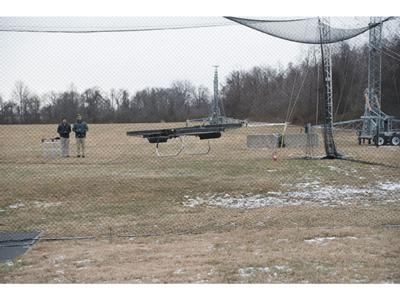Could Eventually Be Used For Autonomous Resupply Missions
The U.S. Army Research Laboratory and industry partners demonstrated the flying capabilities of a unique rectangular-shaped quadcopter during a visit from DOD officials at APG Jan. 10.

Dr. William Roper, director of the Strategic Capabilities Office at the Office of the Secretary of Defense and members of his staff visited the laboratory to see the Joint Tactical Aerial Resupply Vehicle, or JTARV.
Also known as the hoverbike, the vehicle may one day make it possible for Soldiers on the battlefield to order resupply and then receive those supplies rapidly.
During the visit, Roper told laboratory officials that he is concerned about adapting future technology advances. He said he wants to figure out how to get people to "see something that's coming on the shelf, immediately identify the use, determine if it's good enough for rock and roll, get it into the field, but in way that allows us to keep one-upping it."
Researchers see a future JTARV flying low to the ground or at thousands of feet at speeds of 60 miles per hour or more. "Anywhere on the battlefield, Soldiers can potentially get resupplied in less than 30 minutes," said Tim Vong, associate chief of ARL's Protection Division. He likened the concept to "Amazon on the battlefield." "We want to have options like that," he said.
While the current prototype is electric, researchers are looking at a hybrid propulsion system that may dramatically increase range. "We're exploring increasing payload capacity to 800 pounds and extending the range up to 125 miles," Vong said. "We're also looking to integrate advanced intelligent navigation and mission planning. We're looking to end up with a modular, stable platform that can be used for even more dynamic and challenging missions."
The laboratory began exploring the JTARV concept in the summer of 2014. They discovered a manufacturer, Malloy Aeronautics, and a systems integrator, SURVICE. The laboratory entered into a contract and quickly moved from concept to full-scale prototypes.
The JTARV is now a joint effort with the U.S. Marine Corps and led by Army researchers at the U.S. Army Armament Research, Development and Engineering Center at Picatinny Arsenal, New Jersey; however, the ARL researchers still serve as subject matter experts on aeromechanics, assessment, analysis, propulsion, intelligence and controls and materials and structures. "The project is successful because we went from concept development to engineering evaluation in collaboration with all various government agencies and industry," said Ernesto Garcia Lopez, ARDEC.
"The demo we saw was a unique opportunity for us to show a seamless transition between one Army organization and another Army organization and having the industry along the whole time," Garcia Lopez said.
In addition to many other industry, government and academic partners, the JTARV project is teaming with the Office of Naval Research. They hope to demonstrate full autonomy in near future, Vong said. "I think the visit was a great success," Vong said. "It gave us an opportunity to showcase to Dr. Roper ideas and also the progress we've been making in exploiting commercial UAS technologies."
(Image provided with U.S. Army Research Laboratory news release)
 Bolen Gives Congress a Rare Thumbs-Up
Bolen Gives Congress a Rare Thumbs-Up The SportPlane Resource Guide RETURNS!!!!
The SportPlane Resource Guide RETURNS!!!! Buying Sprees Continue: Textron eAviation Takes On Amazilia Aerospace
Buying Sprees Continue: Textron eAviation Takes On Amazilia Aerospace Hawker 4000 Bizjets Gain Nav System, Data Link STC
Hawker 4000 Bizjets Gain Nav System, Data Link STC Echodyne Gets BVLOS Waiver for AiRanger Aircraft
Echodyne Gets BVLOS Waiver for AiRanger Aircraft



